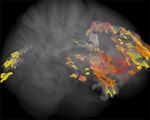
People routinely encounter familiar components from everyday life in new combinations, such as when a co-worker takes on a new role or a sentence uses a word in a new way.
We typically excel at interpreting these new experiences, but researchers do not yet understand the neurological basis of this phenomenon. How does the brain assemble new ideas from familiar parts?
Using computer simulations of the human brain, Professor David Noelle and his colleagues have uncovered an answer to this question, reported this week in a paper highlighted in The Proceedings of the National Academy of Sciences (PNAS). This research suggests that parts of the brain might use a trick that is commonly used by modern computer programmers.
 Noelle and his colleagues have been studying the prefrontal cortex – a large brain region at the front of the head that is important for reasoning, planning and controlling behavior in novel situations.
Noelle and his colleagues have been studying the prefrontal cortex – a large brain region at the front of the head that is important for reasoning, planning and controlling behavior in novel situations.
They found that, over the course of brain development, portions of the prefrontal cortex could come to function in the same way “pointers” do in computer science – they don’t store information, but they store the location of information.
These neural “pointers” make it easy for the brain to recombine familiar concepts in radically new ways, supporting our abilities to think about novel situations and entertain flights of the imagination.
This research was conducted with Trenton Kriete, the first person to receive a Ph.D. in cognitive science from UC Merced and a former graduate student in Noelle’s laboratory, as well as collaborators at the University of Colorado at Boulder and Princeton University.
Together, these researchers have offered an account of how “pointers” might arise in the brain, called the Prefrontal Cortex / Basal Ganglia Working Memory Model.
“For decades, cognitive scientists have wrestled with this issue of how the mind can ‘slot in’ new concepts into old slots,” said Professor Michael Spivey of the UC Merced Cognitive and Information Sciences program. “If you hear, for the first time, the sentence ‘John porched the newspaper,’ you can instantly make your own new version, such as ‘Larry porched the magazine,’ even though you’ve never heard that particular sentence.
“This amazing ability to assign new values to existing variables has led some theorists to propose cognitive mechanisms that are successful at this process but are not biologically plausible,” he said. “Dave Noelle’s work here is a truly groundbreaking step toward a biologically plausible model of how prefrontal cortex and basal ganglia may cooperate to perform this complex function.”
While this research focuses on understanding how biology gives rise to complex aspects of cognition, it could also shed light on deficits seen in ADHD, autism spectrum disorders and a variety of learning disorders.
“I’m very happy that PNAS has chosen to highlight this article,” Noelle said. “I hope it draws attention to research that bridges the gulf between higher-order cognition and the biology of the brain.”
Noelle has been contributing to the Cognitive and Information Sciences program within the School of Social Sciences, Humanities and Arts since 2006. Today’s publication represents just one of the many exciting research programs being pursed by cognitive scientists at UC Merced.
“We’re building an amazing cognitive science program here,” Noelle said.






